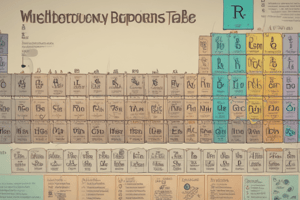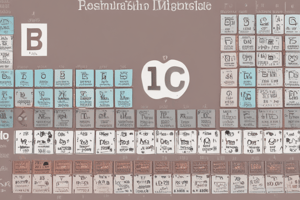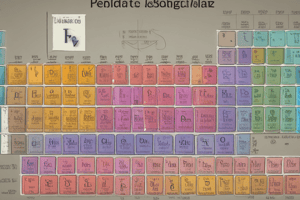Podcast
Questions and Answers
Alkali metals are located on the right side of the periodic table.
Alkali metals are located on the right side of the periodic table.
False (B)
Transition metals are classified into three categories: alkali feldspars, alkaline earth metals, and transition elements.
Transition metals are classified into three categories: alkali feldspars, alkaline earth metals, and transition elements.
False (B)
Elements in the same region of the periodic table have different properties.
Elements in the same region of the periodic table have different properties.
False (B)
Metals are located on the right side of the periodic table.
Metals are located on the right side of the periodic table.
Compounds are easily formed by the interaction of alkali metals with other substances.
Compounds are easily formed by the interaction of alkali metals with other substances.
Calcium and magnesium are examples of alkali metals.
Calcium and magnesium are examples of alkali metals.
Most transition metals are Shiny and react quickly with other materials.
Most transition metals are Shiny and react quickly with other materials.
Metalloids conduct electricity at both high and low temperatures.
Metalloids conduct electricity at both high and low temperatures.
Nonmetals are mostly found in the form of gases or brittle solids at room temperature.
Nonmetals are mostly found in the form of gases or brittle solids at room temperature.
Noble gases react readily with other elements under normal conditions.
Noble gases react readily with other elements under normal conditions.
Halogens are non-metallic trace elements found to the left of noble gases.
Halogens are non-metallic trace elements found to the left of noble gases.
Chlorine reacts with sodium to form potassium chloride.
Chlorine reacts with sodium to form potassium chloride.
Flashcards are hidden until you start studying




